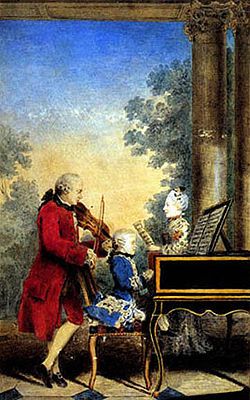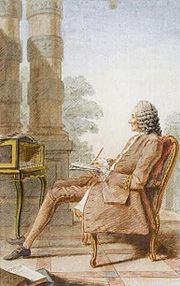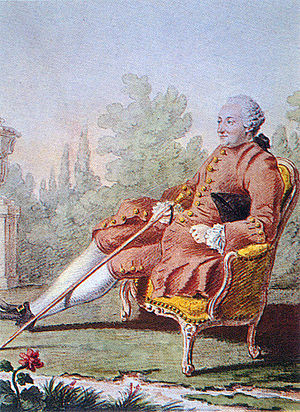
Louis Carrogis Carmontelle
Encyclopedia



France
The French Republic , The French Republic , The French Republic , (commonly known as France , is a unitary semi-presidential republic in Western Europe with several overseas territories and islands located on other continents and in the Indian, Pacific, and Atlantic oceans. Metropolitan France...
dramatist, painter, architect, set designer and author, and designer of one of the earliest examples of the French landscape garden
French landscape garden
The French landscape garden is a style of garden inspired by idealized Italian landscapes and the romantic paintings of Hubert Robert, Claude Lorrain and Nicolas Poussin, European ideas about Chinese gardens, and the philosophy of Jean-Jacques Rousseau...
, Parc Monceau
Parc Monceau
Parc Monceau is a semi-public park situated in the 8th arrondissement of Paris, France, at the junction of Boulevard de Courcelles, Rue de Prony and Rue Georges Berger. At the main entrance is a rotunda. The park covers an area of 8.2 hectares ....
in Paris. He also invented the transparent, an early ancestor of the magic lantern
Magic lantern
The magic lantern or Laterna Magica is an early type of image projector developed in the 17th century.-Operation:The magic lantern has a concave mirror in front of a light source that gathers light and projects it through a slide with an image scanned onto it. The light rays cross an aperture , and...
and motion picture, for viewing moving bands of landscape paintings.
Carmontelle came from a modest background- his father was a bootmaker. He studied drawing and geometry, and at the age of twenty three qualified for the title of engineer, and entered the service of the Duc de Chevreuse and the Duc de Luynes at the Château de Dampierre
Château de Dampierre
The Château de Dampierre is the castle in Dampierre-en-Yvelines, in the Vallée de Chevreuse, France.Built by Jules Hardouin-Mansart, 1675-1683 for the duc de Chevreuse, Colbert's son-in-law, it is a French Baroque château of manageable size...
, where he taught drawing and mathematics to the children.
In 1758, he entered the service of the Comte Pons de Saint-Maurice, governor of the Duc de Chartres and commander of regiment of Orléans-dragons as a topographical engineer. In addition to his drawing duties, he wrote farces and tales. After 1763 entered into the service of Louis Philippe I, Duke of Orléans
Louis Philippe I, Duke of Orléans
Louis Philippe d'Orléans known as le Gros , was a French nobleman, a member of a cadet branch of the House of Bourbon, the dynasty then ruling France. The First Prince of the Blood after 1752, he was the most senior male at the French court after the immediate royal family. He was the father of...
as a lecteur, responsible for providing theatrical performances for the family. He wrote and directed plays, decorated the scenery and made the costumes. In this way he invented a new genre of play, the proverbe dramatique, a scene of light comedy designed to be a point of departure for a theatrical improvisation. He also wrote plays for the famous ballerina, Marie-Madeleine Guimard for performance at the private theater of her residence, Pantin.
In addition to his work in the theater, he was a talented artist, who made portraits in pen and watercolor in less than two hours of notable people that he met. The most famous of his drawings is that of the infant Mozart playing the clavier.
Parc Monceau
In 1773, he was asked by the Duc de Chartres, the son of Louis-Philippe d'Orléans and the future Philippe Egalité, to design a garden around a small house that he was building to the northwest of Paris. Between 1773 and 1778, he created the folie de Chartres, (now Parc MonceauParc Monceau
Parc Monceau is a semi-public park situated in the 8th arrondissement of Paris, France, at the junction of Boulevard de Courcelles, Rue de Prony and Rue Georges Berger. At the main entrance is a rotunda. The park covers an area of 8.2 hectares ....
), one of the most famous French landscape garden
French landscape garden
The French landscape garden is a style of garden inspired by idealized Italian landscapes and the romantic paintings of Hubert Robert, Claude Lorrain and Nicolas Poussin, European ideas about Chinese gardens, and the philosophy of Jean-Jacques Rousseau...
s of the time. It departed from the more natural English landscape gardens of the time by presenting a series of fantastic scenes designed "to unite in one garden all places and all times.". It included a series of fabriques, or architectural structures, while illustrated all the styles known at the time; antiquity, exoticism, Chinese, Turkish, ruins, tombs, and rustic landscapes, all created to surprise and divert the visitor.
After the death of the duc d'Orleans in 1785, Carmonetelle entered into the service of the Duc de Chartres, and taught drawing to his son Louis-Philippe of France
Louis-Philippe of France
Louis Philippe I was King of the French from 1830 to 1848 in what was known as the July Monarchy. His father was a duke who supported the French Revolution but was nevertheless guillotined. Louis Philippe fled France as a young man and spent 21 years in exile, including considerable time in the...
, the future and last King of France, and his sister Adeleide .

